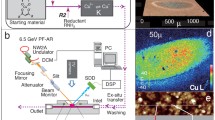Abstract
Metal clusters have been produced using a laser evaporation source. A Nd-YAG laser beam focused onto a solid silver rod was used to evaporate the material, which was then cooled to form clusters with the help of a pulsed high pressure He beam. TOF mass spectra of these clusters reveal a strong occurrence of small and medium sized clusters (n<100). Clusters were also deposited onto grid supported thin layers of carbon-films which were investigated by transmission electron microscopy. Very high resolution pictures of these grids were used to analyze the size distribution and the structure of the deposited clusters. The diffraction pattern caused by crystalline structure of the clusters reveals 3-and 5-fold symmetries as well asfcc bulk structure. This can be explained in terms of icosahedron and cuboctahedron type clusters deposited on the surface of the carbon layer. There is strong evidence that part of these cluster geometries had already been formed before the depostion process. The non-linear dependence of the cluster size and the cluster density on the generating conditions is discussed. Therefore the samples were observed in HREM in the stable DEEKO 100 microscope of the Fritz-Haber-Institut operating at 100 KV with the spherical aberrationc S =0.5 mm. The quality of the pictures was improved by using the conditions of minimum phase contrast hollow cone illumination. This procedure led to a minimum of phase contrast artefacts. Among the well-crystallized particles were a great amount of five- and three-fold symmetries, icosahedra and cuboctahedra respectively. The largest clusters with five- and three-fold symmetries have been found with diameters of 7 nm; the smallest particles displaying the same undistorted symmetries were of about 2 mm. Even smaller ones with strong distortions could be observed although their classification is difficult. The quality of the images was improved by applying Fourier filtering techniques.
Similar content being viewed by others
References
Dietz, T.G., Duncan, M.A., Powers, D.E., Smalley, R.E.: J. Chem. Phys.74, 6511 (1981)
Bondybey, V.E., English, J.H.: J. Chem. Phys.76, 2165 (1982)
Begemann, W., Dreihöfer, S., Ganteför, G., Siekmann, H.R., Meiwes-Broer, K.H., Lutz, H.O.: Elemental and molecular clusters: In: Springer series on material science, p. 230–253, Martin, T.P. (ed.). Berlin, Heidelberg, New York: Springer 1988
Giorgio, S., Urban, J.: Appl. Phys. Lett.52 (18), 1467 (1988)
Whetten, R.L., Cox, D.M., Trevor, D.J., Kaldor, A.: J. Phys. Chem.89, 566 (1985)
Dietz, T.G., Duncan, M.A., Smalley, R.E., Cox, D.M., Horsley, J.A., Kaldor, A.: J. Chem. Phys.77, 4417 (1982)
Author information
Authors and Affiliations
Rights and permissions
About this article
Cite this article
Faust, P., Brandstättner, M. & Ding, A. The structure of deposited metal clusters generated by laser evaporation. Z Phys D - Atoms, Molecules and Clusters 21, 285–288 (1991). https://doi.org/10.1007/BF01426387
Received:
Revised:
Issue Date:
DOI: https://doi.org/10.1007/BF01426387




